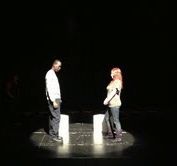Writing en masse with teenaged students is very different from writing and co-producing my own work. Learning to do this has been a gradual process. When I first became a drama teacher (this is my third year teaching drama full-time), I wrote for my students based on their strengths, interests, and my number of committed kids. For the school play I ended up with eight young women and two young men, and wrote a modern adaptation of Aristophanes’ Lysistrata. In the original the women of Athens withhold sex to end war. In our version, Lyza, a group of young women reach their tipping point – in order to dissuade their boyfriends from spreading gang violence, they refuse to text, speak with, or hang out with their significant others. I adapted sections of choral verse and the girls themselves provided a haunting tune to sing it in, a cappella. It worked well, but I was aware that they could have had more power over the development and direction of the script.
Next, I created an “outline” for a play focused on two high school graduates backpacking in India, one of whom dreams of being the next Bollywood star. I wrote the first few scenes, a middle scene, and a final scene. All the in-between was on them. I typed while they improvised, there was a lot of back and forth, and we pieced together what worked best. (We also have a great group of South Asian dancers at our school, who developed their own choreography to compliment the story.) The play was wonderfully comedic, but also had some awkward transitions and underdeveloped relationships. Yet it was more “theirs” than “mine,” and their experience is the whole point, after all.
Whether I should write for them or with them is a constant question. I believe different goals require different approaches. This fall I once again wrote something in its entirety – a Hunger Games inspired piece, which resonated with their passion for dystopian fiction. I would have liked to let them write more scenes, but I had a record number of students audition and wanted to accommodate as many as possible – I believe maximizing and spreading the opportunities should be central to teaching drama. It would have been really difficult to balance their many ideas, and finding consensus would have been impossible in the time available. So I wrote something that had a variety of capsule scenes with additional large group sections. In their small groups, they did background improvisation to create extra scenes, which didn’t end up in the play but hopefully informed their acting. We also utilized tableaux; almost every actor (twenty two actors in total) remained onstage for the entire show.
I’m currently co-developing scenes to weave together our school’s annul multicultural celebration. This time we’re working on the whole process as a collective. I am giving them very little foundation to build upon, yet it’s coming along smoothly. After contemplating my past experiences, this is the process we’re using:
1) Theme and setting I provide the theme; they select a setting.
2) Improvisation / Writing (…Back and Forth!) They improvise, I type, they improvise, I type…and so on. I literally watch them with my laptop on my lap and we bounce back and forth and see what works and what doesn’t. We sit around my lap top together, and consult and compare. We also edit together as they develop their scenes.
3) Is it cohesive? Once it’s written, I provide them all with scripts. We do a read-through to ensure it flows.
4) Rehearsal and Revision Self explanatory! Myself and a senior student will provide feedback.
5) The performance!
It’s simple, but this process works for us. In the context of the classroom, the initial back and forth followed by more streamlined rehearsals lets everyone have a voice, but still ensures we have a product within a limited time frame. But I’m always open to new ideas…

